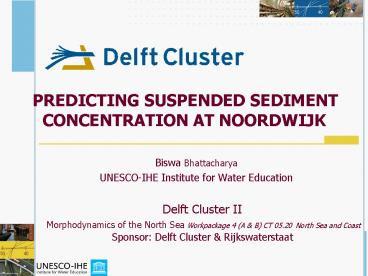PREDICTING SUSPENDED SEDIMENT CONCENTRATION AT NOORDWIJK - PowerPoint PPT Presentation
1 / 24
Title:
PREDICTING SUSPENDED SEDIMENT CONCENTRATION AT NOORDWIJK
Description:
Data-driven modelling - introduction ' ... ANN models were built to estimate the missing wave height and wave periods. The accuracy of the models is high ... – PowerPoint PPT presentation
Number of Views:158
Avg rating:3.0/5.0
Title: PREDICTING SUSPENDED SEDIMENT CONCENTRATION AT NOORDWIJK
1
PREDICTING SUSPENDED SEDIMENT CONCENTRATION
AT NOORDWIJK
- Biswa Bhattacharya
- UNESCO-IHE Institute for Water Education
Delft Cluster II Morphodynamics of the North
Sea Workpackage 4 (A B) CT 05.20 North Sea and
Coast Sponsor Delft Cluster Rijkswaterstaat
2
Data-driven modelling - introduction
- "Data-driven" model is defined as a model
connecting the systems input and output
variables with some knowledge about the physical
process - example rainfall-runoff model
- The quality and quantity of measured data is
important - Important methods artificial neural networks,
fuzzy logic, regression and model trees, etc. - DDM is often called input-output models, or
black box models - black box - because the model does not
reproduce how actually the modelled system works,
but just the input-output relationship
3
Data-driven modelling introduction (2)
- Basic idea of DDM minimize the model error by
tuning the model parameters - optimization plays here central role
4
Artificial neural networks - introduction
There are (Ninp1)Nhid (Nhid1)Nout weights to
be identified
- Applications
- Rainfall runoff modelling
- Water level prediction, water systems control
- Sediment transport
- Prediction of harbour sedimentation
ANN demonstration
5
DDM in the context of this workpackage
- Depends upon available data, data analysis and
literature review - Stand alone data-driven models is not the
objective focus is on hybrid modelling - Three types of data are considered
- wind, waves, river discharge, water level, etc.
- sediment concentration (SPM) data along the Dutch
coast - Focus of DDM to model the SPM supply from the
meteo forcing
SPM Suspended particulate matter
6
Data at Noordwijk
- Collected by CEFAS (Centre for Environment,
Fisheries and Aquaculture Sciences, UK) and RIKZ - CEFAS Minipod deployed at three sites, Noordwijk
2, 5 10 - Hourly SPM and wave data during 2000 2002
- Data was collected using a SmartBuoy with Optical
Backscatter technology
7
Data filtering
8
Low pass wave vs low pass SPM
- Low pass SPM is highly correlated with low pass
significant wave height - Time lag of about 10 hours
- Correlation coefficient is between 0.9 and 1.0
9
High pass wave vs high pass SPM
- High pass SPM is less correlated with high pass
significant wave height - Time lag of about 6 hours
- Correlation coefficient is between 0.5 and 0.8
10
Data analysis SPM bed shear stress
11
Storms and calm periods
- SPM do have correlation with bed shear stress
- Relationship is complex, depends upon other
factors
12
Missing data
- ANN models were built to estimate the missing
wave height and wave periods - The accuracy of the models is high
- In the future the possibility of reproducing the
wave data using data-driven models may be
explored
13
Data-driven model at Noordwijk
- Inputs
- Low pass bed shear stress (three time steps)
- SW Wind
- 7Day moving average significant wave height
- Output
- Low pass SPM
- Method ANN modelling
14
Result on training data
15
Result on testing data
16
Result on testing data (2)
17
Testing with another testing data at Noordwijk-10
18
Subsequent steps in using the data-driven model
- Using the data-driven model at other locations
with local hydro-meteo data - Correct the prediction for cross-shore gradients
- Using the data-driven models prediction at the
Southern boundary of a local fine-grid model
(hybrid model)
19
Using the built model at Noordwijk-2
20
Predicted SPM at the south boundary
21
Local model
22
Hybrid modelling
- Use the output (SPM) of data-driven model as the
south boundary of the numerical model
23
Conclusions (2)
- Data-driven models to predict spm from local
(point) hydro-meteo conditions perform
moderately well - Inclusion of other important factors influencing
spm may further improve the accuracy - DDM predicts reasonably well at other locations
it needs more testing at other locations - Further actions
- Use remote sensing to test the DDM
- Improve corrections for cross-shore gradient
- Recommendations
- Collect more data. Presently the spatial and
temoral resolution of SPM measurements are in no
match with the spatial and temporal resolution of
meteo data.
24
Thank you
- Acknowledgement
- Qinghua Ye, Li Wang, Sowed Sewagudde, Johan de
Kok, Thijs van Kessel and Dano Roelvink - Delft Cluster and Rijkswaterstaat































